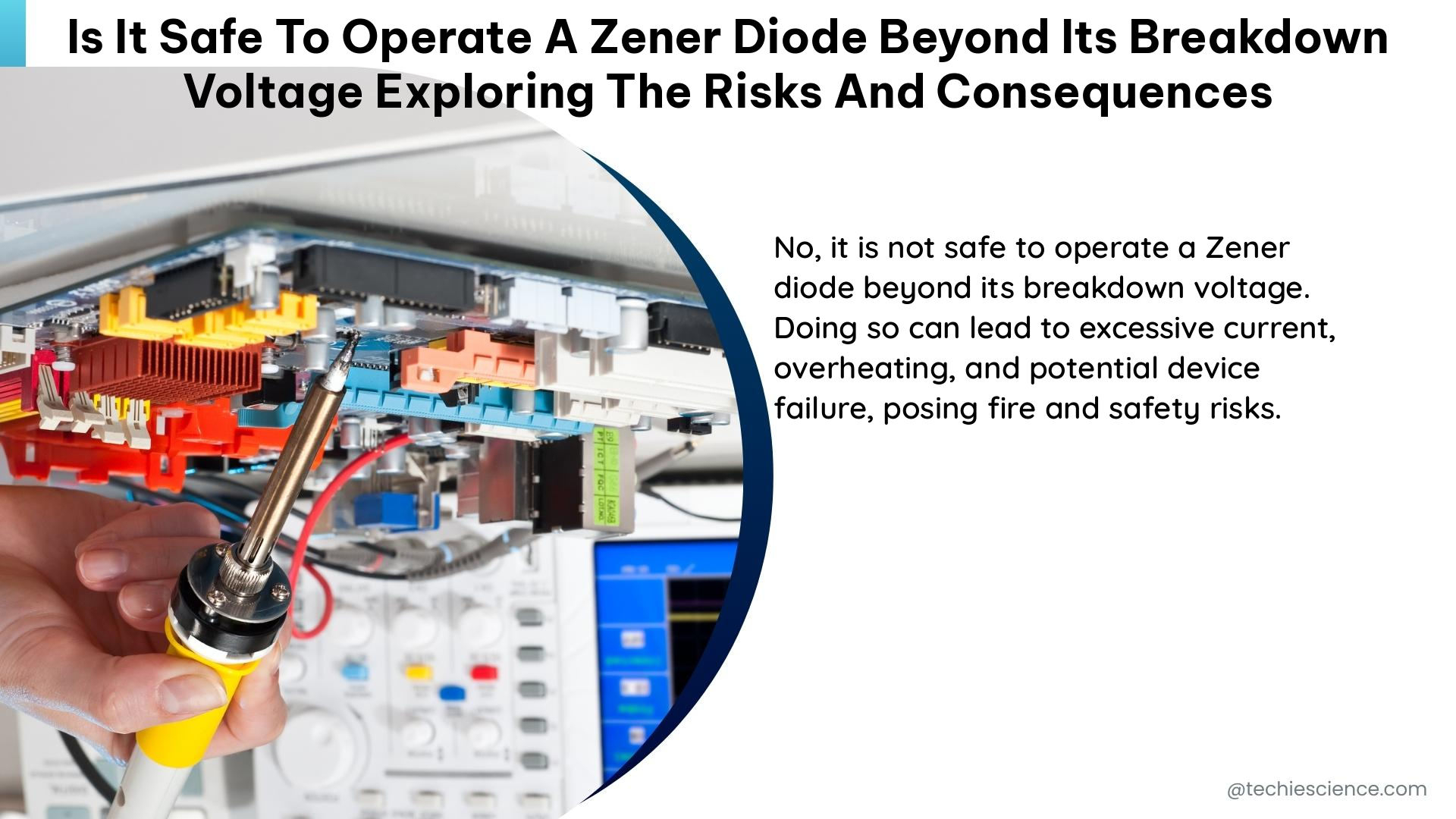Operating a zener diode beyond its breakdown voltage can lead to several risks and consequences, including increased current flow, decreased accuracy, and potential safety hazards. Understanding the proper operation of zener diodes is crucial for ensuring the reliability and safety of electronic circuits.
Understanding Zener Diode Operation
A zener diode is a type of semiconductor diode that is designed to operate in the reverse-biased breakdown region. When the voltage across the zener diode exceeds its breakdown voltage (Vz), the diode starts to conduct current, which helps to maintain a relatively constant voltage across the diode.
The zener diode equation describes the relationship between the zener voltage (Vz), the voltage drop across the resistor (Vr), the current (I), and the zener resistance (rz):
Vz = Vr + I * rz
This equation shows that as the current (I) increases, the voltage drop across the zener diode (Vz) will also increase, even if the input voltage (Vin) remains constant.
Risks of Operating Beyond Breakdown Voltage

- Increased Current Flow: When a zener diode is operated beyond its breakdown voltage, the diode starts to conduct more current. This increased current flow can lead to several issues, such as:
- Overheating and potential damage to the diode
- Increased power dissipation, which can affect the overall circuit performance
-
Potential safety hazards, especially in applications where the zener diode is used for voltage regulation or protection
-
Decreased Accuracy: The zener diode is designed to operate within a specific voltage range, known as the zener voltage (Vz). When the input voltage exceeds this range, the diode’s ability to maintain a constant voltage decreases, leading to inaccuracies in the circuit’s operation.
-
Thermal Runaway: If the zener diode is operated beyond its maximum power dissipation rating, it can lead to thermal runaway, where the diode’s temperature increases rapidly, causing further increases in current and power dissipation. This can ultimately result in the diode’s destruction.
-
Safety Concerns: In applications where zener diodes are used for intrinsic safety, such as in hazardous environments, operating the diode beyond its breakdown voltage can compromise the safety of the system. This can lead to the potential for sparks, fires, or other dangerous situations.
Mitigating the Risks
To mitigate the risks associated with operating a zener diode beyond its breakdown voltage, it is essential to follow these guidelines:
-
Adhere to Manufacturer Specifications: Carefully review the zener diode’s datasheet and ensure that the operating conditions, including the input voltage, current, and power dissipation, are within the recommended limits.
-
Use Regulated Power Supplies: Whenever possible, use a regulated power supply that maintains the voltage within the zener diode’s operating range. This can help prevent the diode from being exposed to voltages that exceed its breakdown voltage.
-
Implement Proper Cooling: Ensure that the zener diode is adequately cooled, either through passive heat sinking or active cooling, to prevent overheating and thermal runaway.
-
Utilize Redundant Safety Measures: In critical applications, such as intrinsic safety systems, consider using redundant zener diodes or other safety components to provide additional protection against fault conditions.
-
Perform Regular Inspections and Maintenance: Regularly inspect the zener diode and the surrounding circuitry for any signs of wear, damage, or degradation. Replace the diode if necessary to maintain the circuit’s reliability and safety.
Numerical Example
Let’s consider a zener diode with a zener voltage (Vz) of 12 V and a zener resistance (rz) of 10 Ω. If the input voltage (Vin) is 20 V, we can calculate the following:
-
Voltage drop across the resistor (Vr):
Vr = Vin – Vz
Vr = 20 V – 12 V = 8 V -
Current (I):
I = Vr / R
I = 8 V / 10 Ω = 0.8 A -
Power dissipated by the zener diode (Pz):
Pz = I * Vz
Pz = 0.8 A * 12 V = 9.6 W
In this example, the zener diode is being operated beyond its breakdown voltage of 12 V, which can lead to the risks and consequences discussed earlier, such as increased current flow, decreased accuracy, and potential safety hazards. Proper precautions and design considerations are necessary to ensure the safe and reliable operation of the zener diode in this scenario.
Conclusion
Operating a zener diode beyond its breakdown voltage can be risky and can lead to several consequences, including increased current flow, decreased accuracy, and potential safety hazards. It is essential to adhere to the manufacturer’s specifications, use regulated power supplies, implement proper cooling, and utilize redundant safety measures to mitigate these risks. Regular inspections and maintenance are also crucial to ensure the continued safe and reliable operation of the zener diode in electronic circuits.
Reference:
- Rockwell Automation. (2016). Zener Barriers. Retrieved from https://literature.rockwellautomation.com/idc/groups/literature/documents/td/937-td003_-en-p.pdf
- Deeter Electronics. (n.d.). 3-Channel Zener Diode Safety Barrier ZSB-409A. Retrieved from https://www.deeterelectronics.com/us/product/ultrasonic-level-flow-sludge-proximity-sensors/hazardous-area-ultrasonic-sensors-intrinsically-safe-explosion-proof/3-channel-zener-diode-safety-barrier-zsb-409a/
- Extech. (2021). Intrinsic Safety: How does a Zener barrier work? Retrieved from https://extech.co.za/how-does-a-zener-barrier-work

The lambdageeks.com Core SME Team is a group of experienced subject matter experts from diverse scientific and technical fields including Physics, Chemistry, Technology,Electronics & Electrical Engineering, Automotive, Mechanical Engineering. Our team collaborates to create high-quality, well-researched articles on a wide range of science and technology topics for the lambdageeks.com website.
All Our Senior SME are having more than 7 Years of experience in the respective fields . They are either Working Industry Professionals or assocaited With different Universities. Refer Our Authors Page to get to know About our Core SMEs.